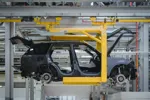Authors: David Bale (pictured), senior business relationship manager in the automotive practice at Tata Consultancy Services and Srini Rajagopal is a senior consultant in TCS Digital Services.
"Digital has radically changed the world we live in, and affects many aspects of our lives. In the commercial world, it continues to create business new models and opportunities, transforming the way business is done. If you’re in any doubt of the transformative power of digital, consider how it helped Apple reinvent music delivery or Google revolutionise research. What can digital do for dealerships?
Digital can, and will, drive dealer group sales and performance. It will enable dealerships to build market leading relationships with potential and existing customers, and OEMs. It will inform smart decision making, new products and services, and reduce waste.
But to take advantage of the very real opportunities digital presents, dealerships must reinvent their business strategies.
Key to this is to understand the nature of the five digital forces which are shaping the world we live in. This article - based on extensive research into leading companies across a variety of industries - defines these forces, and how dealerships can best leverage them.
1. Mobility and pervasive computing
Devices that allow us to go digital anytime, anywhere. If you want an anecdote to demonstrate the pervasive nature of digital consider this: the average person now owns more mobile phones than toothbrushes. In the modern world, humans express their innate desire to communicate through digital channels, and spend less time communicating face to face.
To harness this force, a dealership must not only have a presence online, but also must deliver online services to customers through their chosen device. The services must be relevant, branded and, ideally, differentiate the dealership. This is a key channel to customers, and dealerships should not consider that it is simply a case of finding a way to present their ‘traditional’ communications online. Rather, communications need to be “re-imagined” to be truly effective in this environment.
But re-imagination alone is not enough. Connectivity, device support and the storage of customer preferences and options will differentiate the winners in this area, just as much as the re-imagination itself. Take connectivity. A complex data flow may be disrupted by poor connections. It is critical that a customer, regardless of the device they are using, can re-enter a transaction at the point where they left. If a customer has to start the process again, they may go elsewhere.
Mobile devices also feature heavily in the showroom and the workshop. By going paperless, data can be consolidated and issues or opportunities escalated automatically and instantly (for both sales and aftersales). Currently this may take the form of digital dashboards and routing through call centres. In both areas the additional information that can be brought into play offers very interesting opportunities and cannot be ignored by a dealer.
2. Big data analytics
Secrets are hidden in huge volumes of data, but can be unlocked to provide new insights. Extremely large volumes of data - or ‘big data’ - can be analysed to reveal patterns, business trends and associations. Leveraging this insight can help dealerships to truly understand their customers and therefore make better decisions. It can drive business growth by reducing waste and increasing the quality of products and services that you know your customers will want.
However, in order to use big data, it is first necessary to store it, search it and analyse it. By its very nature, big data is too large to process and store using traditional techniques and so new methods are needed. Another challenge is that very little of the world’s data is tagged with metadata (which provides information about the data that is needed for analysis, such as how, when and by whom it was collected). Insights into the data cannot be derived just by reviewing the data: specialised software tools are needed to reveal patterns, and these need calibrating and tuning against reference data.
An indicator of the power of big data is the amount of investment that is being made in it, despite these challenges.
Across industries, more money is being spent on big data analytics than any of the other digital forces. Last year, Tata Consultancy Services revealed the findings of its worldwide 'Big Data Study', and one of the key findings was that approximately half of the 1,217 large companies surveyed were using 'big data', with many of them predicting big returns.
3. Cloud technologies
Redefining scaleability and speed. While the name Cloud is ambiguous, the business problems it addresses are clearly defined:
> Companies are able to future proof their IT hardware and software investment. Upgrades become the responsibility of the service provider
> Companies are able to scale their IT hardware and software footprint. Often costs savings can be realised as computer and storage requirements are reduced to essential levels by the service provider. Scaleability also allows for rapid business expansion. Mergers and acquisitions can be backed with a solid systems plan
> Companies are able to ensure service performance (and disaster recovery) as the service provider commits to these service levels.
4. Social media
Revolutionising communications. Everybody has social listening in place to some degree, and is reacting to information from these streams. Social platforms have transformational potential.
Take crowdsourcing, which is a process of soliciting help from a large group of people at the same time. Crowdsourcing is not only limited to small investors with new ideas; a crowdsource process can be used to drive ideas that develop products or additional customer offerings. A crowdsource process could be used by technicians across a group to focus on resolving a specific repair issue. For example, instead of a single technician writing up per job card, every technician in the group would view related write-ups in real time.
Another example is gamification, where game design techniques (such as point scoring, competition etc) are used to encourage engagement with a scheme, product or service. With gamification, the whole workforce and, potentially, customers, can be engaged in reward and recognition schemes that drive success. Targets will drive sales just as they always did, but the new platforms will allow targets to be set in ever more centrally structured ways.
5. Artificial intelligence and robotics
This is the next, relatively unexplored stage in digital. Every car, and in fact every electrical item will soon come complete with its own ‘brain’. This will allow new processes that were previously impossible to deliver. For example, cars will be able to predict the preferences of their drivers – and adjust to those preferences. Engaging sport mode or efficient cruising; Off Road or AWD handling and suspension settings; Interior comfort and infotainment settings; automatic adjustment to external weather and traffic conditions. All of these can be refined dynamically to continually surprise and delight the customer.
Cars will also be able deliver up to the minute diagnostics. In roadside repair situation for example, where the probable cause of the breakdown and potential fix can be worked on before the technicians arrive at the scene.
Conclusion – Bringing it all together
While this article separates the five digital forces, it is important to note that new business models evolve as these five forces combine. It is worth the time to understand these forces and rethink strategies in order to leverage the potential that digital offers.
Research conducted in other industries suggests that well defined web site visits can predict end sales. For example, customers who we know have engaged well online (for example, built a model car with more than three customisations, or navigated across at least eight pages) and then dropped in a lead need to be prioritised as high potential.
The quality of the leads fed to a dealer from an OEM could be correspondingly high, depending on how the OEM qualifies them.
In the case of one mobile phone manufacturer, it was found that the average time between a potential customer conducting research on the manufacturer’s website (within set micro-behaviour parameters as defined by the manufacturer) and the actual sale was three weeks. There was a very strong correlation between the two: a spike in online behaviour tended to manifest itself offline, in the form of a spike in sales, three weeks later.
Data of this nature must be captured and analysed by dealers today.
It is essential that dealers understand the basic level business requirements for digital. The customer may not always choose to respond in the same channel they received the communication.
The question then becomes which channel will get the credit, which becomes important when budgets are allocated on the ROI they deliver. Irrespective of this, if a customer configures options on one channel, there is significant benefit if these are presented to the customer on all other channels.
It is important for dealerships to acknowledge that digital continues to evolve, and they must evolve their strategies accordingly. Even with today’s advances, we still have much unexplored potential in social, the Cloud and artificial intelligence (AI).
For more information on Tata’s 'Big Data' study, please go to: http://sites.tcs.com/big-data-study/big-data-study-key-findings/














Login to comment
Comments
No comments have been made yet.